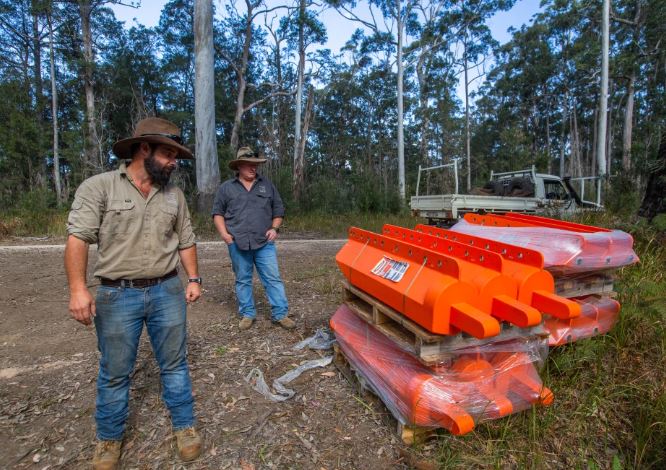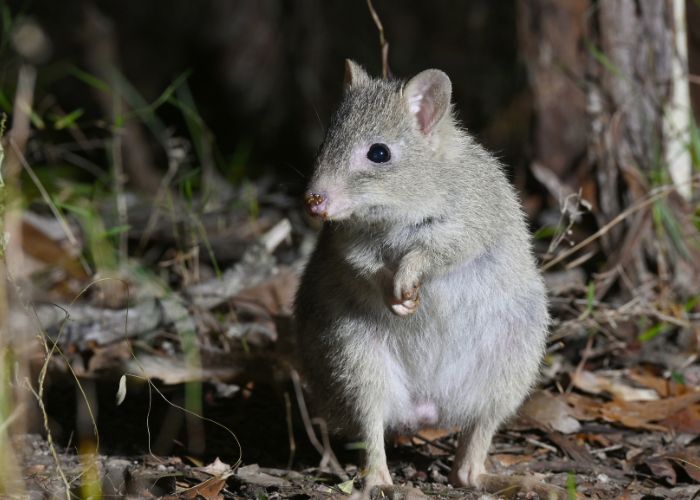Construction begins on a feral predator-free fence for the endangered Northern Bettong
Australian Wildlife Conservancy, Aug 30, 2022
As wild populations dwindle, construction is underway on northern Australia’s first large, feral predator-free safe haven, which will play a critical role in staving off the extinction of the Northern Bettong. This species is listed among the 20 Australian mammals at greatest risk of extinction in the next 20 years.
The first post on the 13-kilometre fence has been installed in the Coane Range at Australian Wildlife Conservancy’s (AWC) Mount Zero–Taravale Wildlife Sanctuary in north-east Queensland. The Coane Range contains prime Northern Bettong habitat, which will allow AWC to reintroduce the species.

Contractor Mike McFall celebrates the instalment of the first post.
Construction of the fence, which will protect an area of 950-hectares, is expected to take up to three months but required three years of planning to ensure it could withstand the environmental stresses of tropical Australia. In addition to being a feral predator-proof fence, it needs to be able to hold out against occasional cyclones and provide a barrier across 30 creeklines. As a result, every fourth post along the fence is a tougher, standstill maxi-post to withstand tropical winds. Special consideration is being given to reinforce creek crossings to help prevent the fence from being swept away during big flows. Thirty-eight motion-sensor cameras have been deployed on a 500-metre grid across the 950-hectare area to detect feral predators during the eradication phase and these cameras will remain in situ to monitor any potential breaches by feral predators. Additional cameras will be deployed along the fence line and road networks during the eradication phase.

Waratah Flood posts are being used across the 30 creeklines to provide an effective barrier. Pictured, Mount Zero–Taravale Sanctuary Manager Josh ‘Macca’ McAllister and Land Management Officer Aaron Harper.
Josh ‘Macca’ McAllister, AWC Sanctuary Manager for Mount Zero–Taravale Wildlife Sanctuary, welcomed the start of construction, saying it’s a momentous and critical step towards protecting the Northern Bettong.
“We have waited three years and worked through a number of unexpected obstacles to get to this point,” Macca explained. “It’s a big operation for a relatively small fence with a lot of challenges… but it will be worth all the effort once we’re able to reintroduce the Northern Bettong, which has been missing in action from this area since about 2004.”
“As we resolve each engineering challenge and get closer to finishing the fence, there’s definitely a renewed sense of hope for the species amongst the team.”

Once complete and declared feral predator-free, AWC will establish a population of the Northern Bettong which is listed among the 20 Australian mammals at greatest risk of extinction in the next 20 years.

After years of planning, consultation, determination and dedication, fence construction is now underway. Pictured, Mount Zero–Taravale Sanctuary Manager Josh ‘Macca’ McAllister and Land Management Officer Aaron Harper.
Once construction is complete and before Northern Bettongs can be reintroduced, Mount Zero’s field team will conduct intensive baiting, trapping and monitoring to remove any feral cats from within the fenced area.
“We already have cameras monitoring the area for predators and they have recorded two cats so far,” said Macca. “But my feeling is that we might have half a dozen to remove.”
Construction of the fence comes at a critical time, with a recent survey of the Northern Bettong population on Mount Carbine Tableland indicating ongoing decline over the last two years. The study was conducted by AWC in partnership with Western Yalanji Aboriginal Corporation (WYAC) Traditional Owners and Rangers as well as Queensland Parks and Wildlife Service (QPWS). Individuals from the population, which is one of the last two surviving wild populations, were detected a mere 26 times during a camera trap survey in April and May 2022, this is a drop from the 117 detections during a prior survey in August 2020.
The small size of this population is very concerning given the recent local extinction of Northern Bettongs at Mount Windsor National Park. The team suggested that changes to habitat structure caused by thickets of invasive Lantana, rainforest encroachment and feral herbivores may be factors that have contributed to the decrease in Northern Bettongs.
“The results of the latest survey are sobering and a reminder that this really is an urgent situation,” said Dr Manuela Fischer, AWC Wildlife Ecologist.
While once found across the Wet Tropics to central Queensland, predation by feral cats, inappropriate fire regimes, and the impact of feral herbivores like pigs and cattle on habitat has seen the species become restricted to the tall, open eucalypt forests and woodlands adjacent to the rainforests of North Queensland. Only two populations remain – one, on the Lamb Range, estimated at fewer than 1,000 individuals, and the second small and declining population on Mount Carbine Tableland.
The establishment of a secure population at Mount Zero–Taravale Wildlife Sanctuary within a 950-hectare feral predator-free area is a critical step in ensuring a future for the species.
In addition to building the fence, AWC will closely monitor the Northern Bettong once it is reintroduced to the site and conduct ongoing management within the fenced area to ensure the habitat remains optimal for the population to grow.
AWC has implemented a land management program at Mount Zero–Taravale for over a decade, specific to managing key threats and restoring the Northern Bettong habitat. Land management has included weed control, destocking of cattle and fencing, and re-establishing a fire regime of frequent, patchy burns with varying intensity. Through these efforts, the grassy understorey of the tall eucalypt forest, the key habitat for the Northern Bettong, is recovering. AWC is working closely with Gugu Badhun Traditional Owners, the Northern Bettong Recovery Team and other key project partners to deliver this critical project.
Construction of the fence at Mount Zero–Taravale is possible thanks to grant funding from the Australian Government, the Oak Foundation, WIRES and Friends of AWC US, as well as donations from AWC supporters around the world.
It will be AWC’s ninth feral predator-free fenced area and the first in northern Australia. Other fenced areas can be found at: Karakamia and Mt Gibson Wildlife Sanctuary in WA, Newhaven Wildlife Sanctuary near Alice Springs in NT, Yookamurra Wildlife Sanctuary in SA, Western River Refuge on Kangaroo Island and Scotia Wildlife Sanctuary in NSW as well as two NSW government partnership sites at Mallee Cliffs National Park and Pilliga State Conservation Area. AWC also manages the feral predator-free Faure Island.
Source: